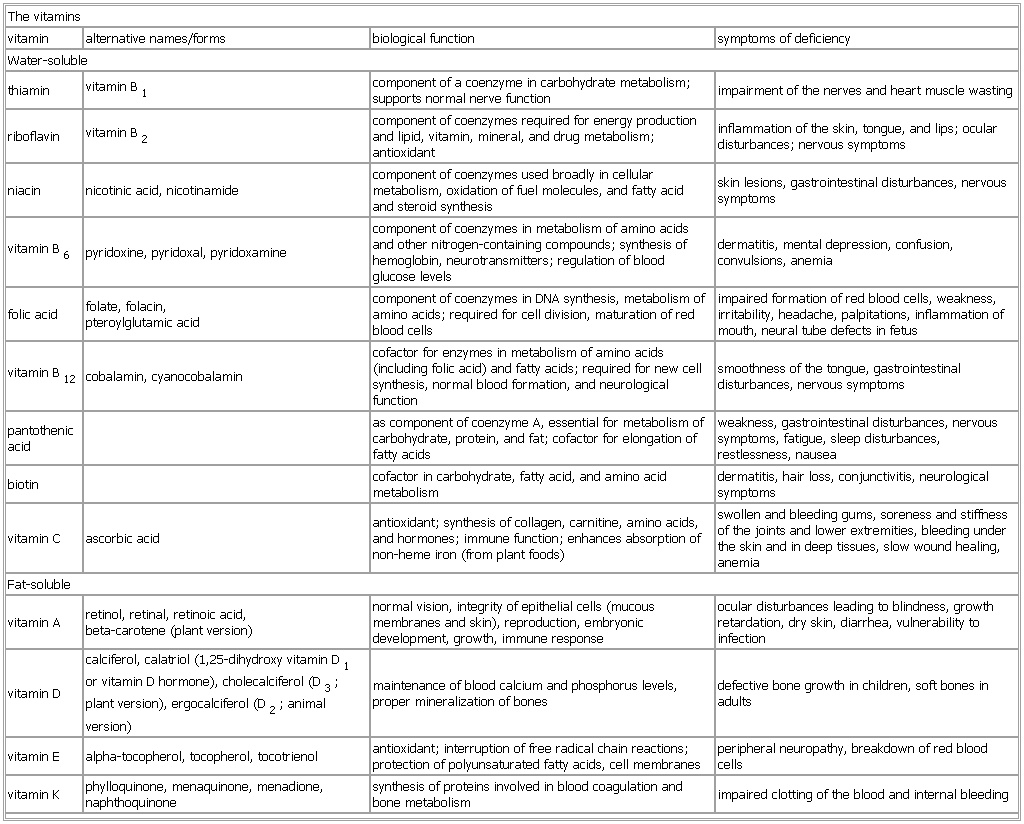- vitamins
-
▪ TableThe vitaminsvitamin alternative names/forms biological function symptoms of deficiencyWater-solublethiamin vitamin B1 component of a coenzyme in carbohydrate metabolism; supports normal nerve function impairment of the nerves and heart muscle wastingriboflavin vitamin B2 component of coenzymes required for energy production and lipid, vitamin, mineral, and drug metabolism; antioxidant inflammation of the skin, tongue, and lips; ocular disturbances; nervous symptomsniacin nicotinic acid, nicotinamide component of coenzymes used broadly in cellular metabolism, oxidation of fuel molecules, and fatty acid and steroid synthesis skin lesions, gastrointestinal disturbances, nervous symptoms6 (vitamin B6) pyridoxine, pyridoxal, pyridoxamine component of coenzymes in metabolism of amino acids and other nitrogen-containing compounds; synthesis of hemoglobin, neurotransmitters; regulation of blood glucose levels dermatitis, mental depression, confusion, convulsions, anemiapteroylglutamic acid component of coenzymes in DNA synthesis, metabolism of amino acids; required for cell division, maturation of red blood cells impaired formation of red blood cells, weakness, irritability, headache, palpitations, inflammation of mouth, neural tube defects in fetus12 (vitamin B12) cobalamin, cyanocobalamin cofactor for enzymes in metabolism of amino acids (including folic acid) and fatty acids; required for new cell synthesis, normal blood formation, and neurological function smoothness of the tongue, gastrointestinal disturbances, nervous symptomspantothenic acid as component of coenzyme A, essential for metabolism of carbohydrate, protein, and fat; cofactor for elongation of fatty acids weakness, gastrointestinal disturbances, nervous symptoms, fatigue, sleep disturbances, restlessness, nauseabiotin cofactor in carbohydrate, fatty acid, and amino acid metabolism dermatitis, hair loss, conjunctivitis, neurological symptomsvitamin C ascorbic acid antioxidant; synthesis of collagen, carnitine, amino acids, and hormones; immune function; enhances absorption of non-heme iron (from plant foods) swollen and bleeding gums, soreness and stiffness of the joints and lower extremities, bleeding under the skin and in deep tissues, slow wound healing, anemiaFat-solublebeta-carotene (plant version) normal vision, integrity of epithelial cells (mucous membranes and skin), reproduction, embryonic development, growth, immune response ocular disturbances leading to blindness, growth retardation, dry skin, diarrhea, vulnerability to infectionvitamin D calciferol, calatriol (1,25-dihydroxy vitamin D1 or vitamin D hormone), cholecalciferol (D3; plant version), ergocalciferol (D2; animal version) maintenance of blood calcium and phosphorus levels, proper mineralization of bones defective bone growth in children, soft bones in adultsvitamin E alpha-tocopherol, tocopherol, tocotrienol antioxidant; interruption of free radical chain reactions; protection of polyunsaturated fatty acids, cell membranes peripheral neuropathy, breakdown of red blood cellsvitamin K phylloquinone, menaquinone, menadione, naphthoquinone synthesis of proteins involved in blood coagulation and bone metabolism impaired clotting of the blood and internal bleedingSee as table:

* * *
Universalium. 2010.
